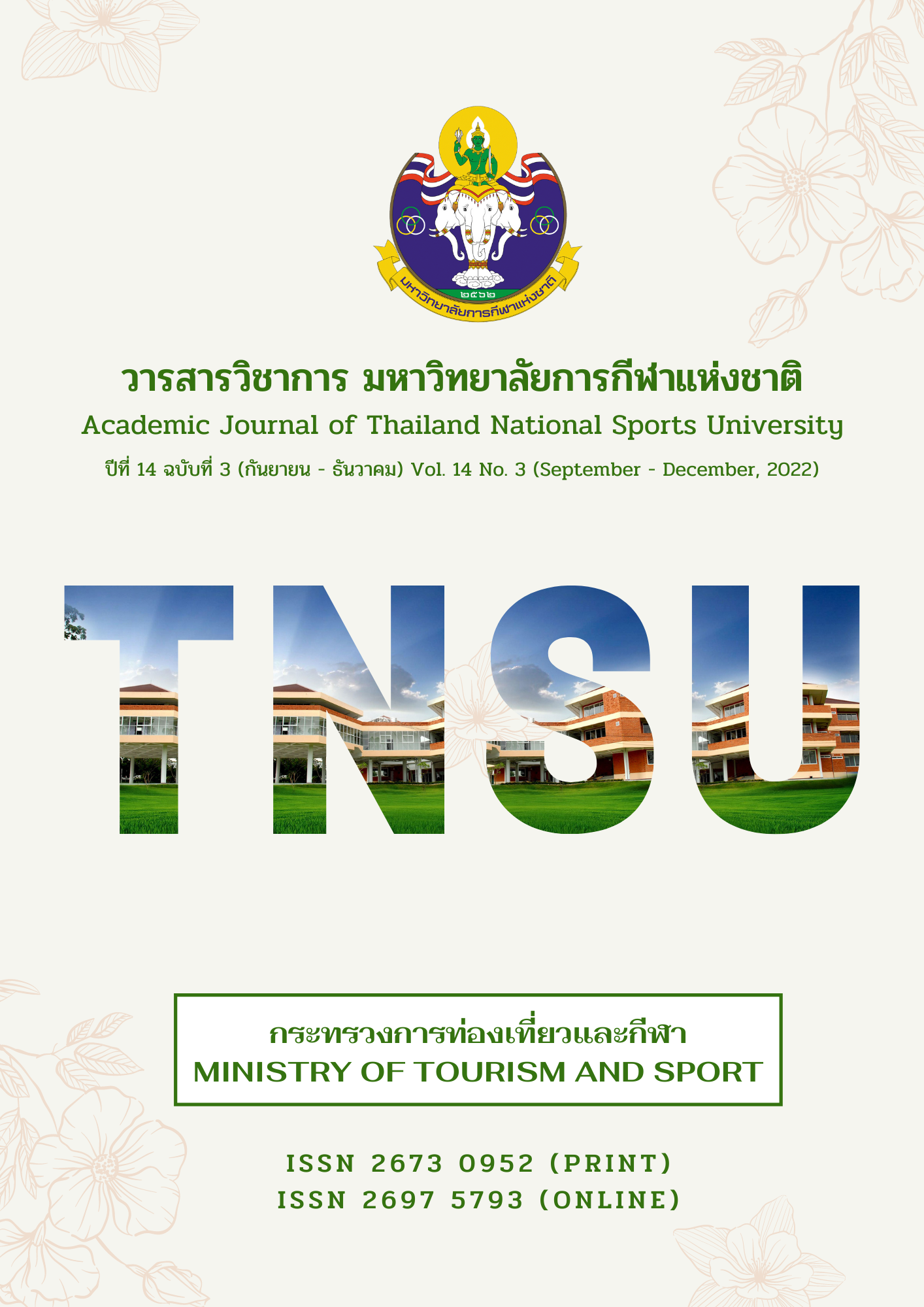DEVELOPMENT OF FOOTBALL SKILL AND CREATIVITY OF PRIMARY SCHOOL STUDENTS USING BRAIN - BASED LEARNING
Main Article Content
Abstract
The research was a study on the development of football skill and creativity of primary school students using brain - based learning, 1) with the purpose to compare the mean scores of football skills and creativity before and after experiments of the experimental group, and 2) compare the mean scores of football skills and post - experiment creativity of the experimental group and control group. The subjects were 40 sixth grade students, divided equally into 20 students for the experimental group who were assigned to study the physical education subject using brain - based learning and 20 students of the control group who were assigned to study with the conventional teaching method. The research instruments were comprised of 8 physical education lesson plans under the using brain - based learning with IOC 0.88 – 0.92 and the development of football skill and creativity test with IOC 0.86 and 1.00. The data were analyzed by mean, standard deviation and t - test. The research findings were as follows: 1) The mean scores of the development of football skill and creativity of the experimental group after learning were significantly higher than that before learning at .05 level, 2) The mean scores of the development of football skill and creativity of the experimental group after experiment were significantly higher than that of the control group at .05 level. Conclusion: The development of football skill and creativity of primary school students using brain - based learning was higher than health education learning management with the conventional teaching method.
Article Details

This work is licensed under a Creative Commons Attribution-NonCommercial-NoDerivatives 4.0 International License.
The published article is a copyright of the Academic Journal of Thailand National Sports University. The passage appeared in each article in this academic journal is a perspective of each author which is not related to the journal. Each author is required to be responsible for all components of his/her own article. If there are any mistakes, each author must be responsible for those mistakes on his/her own.
References
Achira Klinampa. (2016). Effects of thai sword training program based on Guilford’s concept upon creative thinking of higher education students (Master’s thesis). Retrieved from http://cuir.car.chula.ac.th/handle/123456789/55430
Adiphan Prasit. (2016). Development of a brain - based physical education learning management model for develop academic achievement of middle school students. Academic Journal of Institute of Physical Education, 9(2). Retrieved from
http://164.115.27.97/digital/files/original/cdbcfb5934f325befd182434f644c856.pdf
Boyce, B. A. (1992). The effects of three styles of teaching on university students’ motor performance. Journal of Teaching in physical Education, 11, 389 - 401.
Caine, G., & Caine, R. N. (1990). Understanding a brain - based approach to learning and teaching. Educational Leadership, 48(2), 66 – 70.
Chanathip Pornkul. (2011). Teaching Theory Thinking Process and Applying (7th ed.). Bangkok: Srinakharinwirot University.
Chao, Y. C. (2016). The effects of brain - based learning on students’ knowledge structure problem-solving capability and learning motivation in physical education teaching. Bulletin of Educational Research, 62(4), 41 - 84 Retrieved from https://search.proquest.com/docview/1872580739?pq-origsite=gscholar&fromopen view=true
Charoen Krabuanrat. (2016). Techniques for Speed Training. Bangkok: Thaimit Printing.
Chitinthree Boonma. (2009). A physical education instructional model based on brain - based learning approach to enhance learning development and skill - related physical fitness of first grade students (Doctoral dissertation), Retrieved from http://cuir.car.chula. ac.th/handle/123456789/15992
Jirarat Boonsong. (2016). Brain - based learning management on academic achievement and creativity of Mathayomsuksa 2 students (Master’s thesis), Prince of Songkla University Retrieved from http://kb.psu.ac.th/psukb/handle/2016/11077
Ministry of Education. (2017). Early Childhood Education Program 2017, Bangkok: Office of Academic and Educational Standards.
National Advisory Committee on Creative and Cultural Education. (1999). All our futures: creativity, cultural education. London: Department for Education and Employment.
Palita Tanmanee. (2010). The effects of physical education learning management using rhythmic activities based on theory of torrance on creative thinking of fourth grade students (Master’s thesis), Retrieved from http://cuir.car.chula.ac.th/handle/123456789/63953
Panumad Homglin. (2016). Developing basic skills of playing soccer on a set of learning activities that focus on practical skills pratomsuksa 6 (Master’s thesis), Retrieved from https://opac.rmu.ac.th/cgi-bin/koha/opac-detail.pl?biblionumber=120424
Pornpilai Lertwicha, & Akkarapoom Jarupaporn. (2007). Designing a Learning Process using the Brain. Bangkok: Institute of Learning Sciences.
Rink J. (2006). Teaching Physical Education for Learning (5th ed.). Boston: Mcgraw - Hill.
Songsri Buddhakerd. (2018). Effecte of BBL playground on physical fitness and physical intelligence quotient in elementary students. Journal of Graduate Research, 9(2). Retrieved from https://so01.tci-thaijo.org/index.php/OJED/article/view/207007
Suriya Klinbanchuen. (2015). The development of physical education instructional model based on constructivist approach for developing creative thinking and problem solving ability for elementary school students (Master’s thesis), Retrieved from http://cuir.car.chula.ac.th/handle/123456789/49838
Uthai Sanguanpong. (2007). Enjoy Football Fun with Football Series. Volume 2. Bangkok: Developing Quality Academic.
Vicharn Phanich. (2012). A Way to Create Learning for Students in the 21st Century. Bangkok: Sodsri - Saritwong Foundation.
Wade, A. (1968). The F. A. Guide to Training and Coaching. London: Heinemann.

